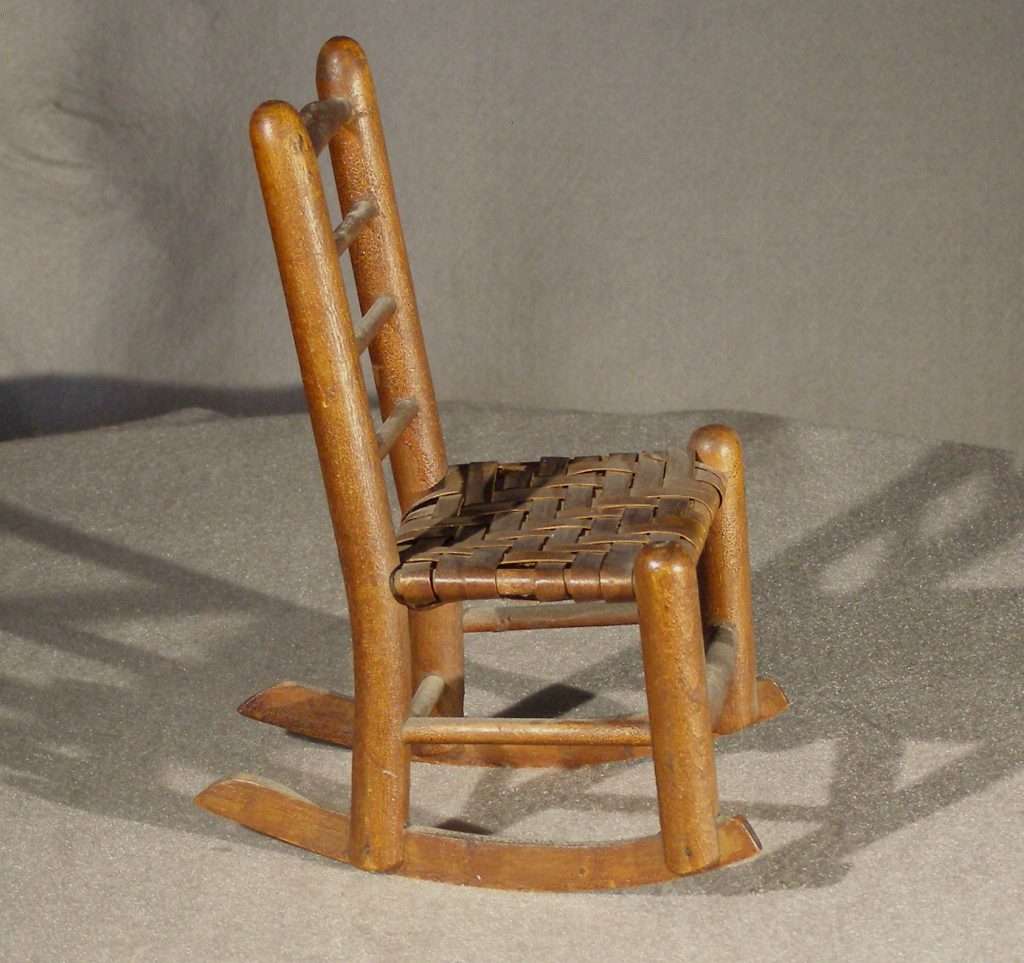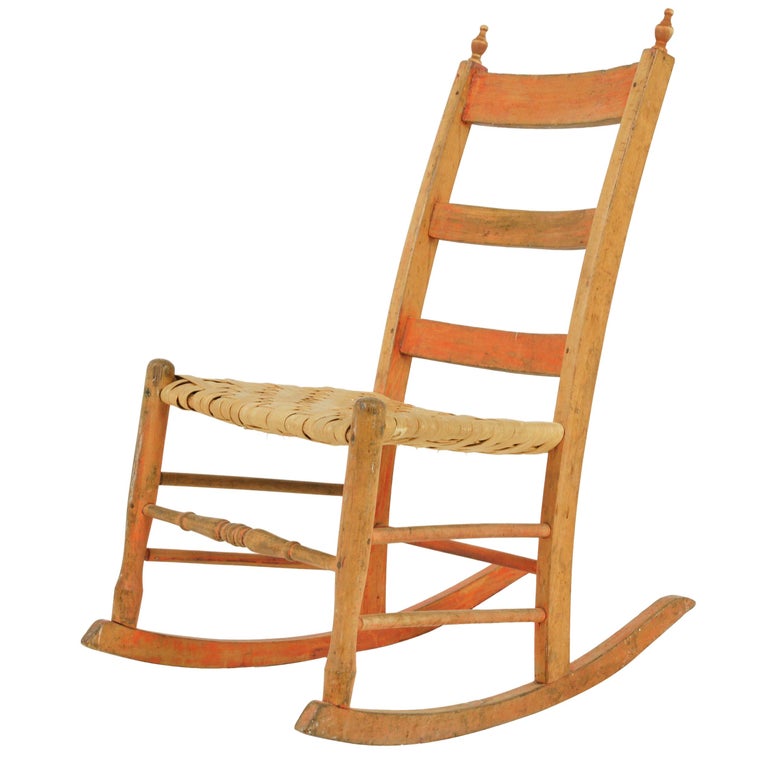History and Origin

The ladder-back rocking chair, a timeless classic, has a rich history that spans centuries. Its evolution reflects the changing tastes and craftsmanship of different eras, from its humble beginnings to its status as a cherished piece of furniture.
Evolution of Design, Antique ladder back rocking chair
The design of the ladder-back rocking chair has evolved over time, with different styles and features emerging in different periods. The earliest ladder-back rocking chairs were simple and utilitarian, with a few rungs and a basic frame. As the craft developed, more intricate designs emerged, including curved backrests, turned spindles, and elaborate carvings.
Design and Construction: Antique Ladder Back Rocking Chair

The ladder-back rocking chair, a timeless piece of furniture, is known for its simple yet elegant design and enduring construction. Its distinctive features, materials, and crafting process contribute to its iconic status and enduring appeal.
Distinctive Features of Ladder-Back Design
The ladder-back design is characterized by its vertical slats, resembling a ladder, that form the chair’s back. These slats are typically spaced evenly and connected by horizontal rails, creating a sturdy and supportive structure. The slats are often crafted from wood, providing a natural and rustic aesthetic.
Materials Used in Construction
The choice of wood for ladder-back rocking chairs varies depending on the region and historical period. Hardwoods such as oak, maple, cherry, and walnut are commonly used for their strength, durability, and attractive grain patterns. These woods are known for their resistance to wear and tear, making them ideal for furniture that is meant to last for generations.
Crafting a Ladder-Back Rocking Chair
The process of crafting a ladder-back rocking chair involves a series of meticulous steps:
- Shaping the Wood: The wood for the chair’s frame, back, and seat is carefully selected and shaped using hand tools or power equipment. The slats for the back are often planed to create a smooth and consistent surface.
- Joining the Pieces: The shaped pieces are joined together using traditional joinery techniques, such as mortise and tenon joints, which ensure a strong and lasting bond. The rocking mechanism is also carefully crafted and integrated into the chair’s frame.
- Finishing the Chair: The finished chair is sanded to a smooth finish and often coated with a protective finish, such as oil, varnish, or wax. This process enhances the wood’s natural beauty and protects it from moisture and damage.
Variations in Rocking Chair Styles
The design of ladder-back rocking chairs has evolved over time, resulting in a variety of styles.
- Early American Rocking Chairs: These chairs often feature a simple, functional design with a high back and a wide, comfortable seat. They are often made from oak or maple and have a natural, rustic finish.
- Victorian Rocking Chairs: Victorian rocking chairs are known for their ornate designs and intricate carvings. They often feature a lower back, curved arms, and a padded seat. They were typically made from mahogany or walnut and finished with a dark, polished stain.
- Modern Rocking Chairs: Contemporary rocking chairs may incorporate more modern materials and designs, but they often retain the classic ladder-back aesthetic. They may feature sleek lines, minimalist details, or unconventional shapes.
Collecting and Restoring

Collecting and restoring antique ladder-back rocking chairs is a rewarding hobby that combines history, craftsmanship, and aesthetics. Whether you’re a seasoned collector or just starting, understanding the factors that influence value, authenticity, and restoration is crucial for making informed decisions.
Evaluating Value
The value of an antique ladder-back rocking chair is determined by a combination of factors, including:
- Age and Origin: Older chairs, especially those with a documented history or provenance, are generally more valuable. Chairs from specific regions or makers may also command higher prices.
- Condition: The overall condition of the chair, including the presence of original finishes, hardware, and upholstery, plays a significant role in its value. Chairs with minimal wear and tear or those that have been well-maintained are more desirable.
- Material and Craftsmanship: The type of wood used, the quality of the joinery, and the craftsmanship displayed in the chair’s construction all contribute to its value. Chairs made from high-quality hardwoods, with intricate carving or inlay, are often more valuable.
- Rarity and Demand: Chairs with unique features, such as unusual designs or specific maker’s marks, are more sought-after and may command higher prices. The overall demand for a particular style or period of chair can also affect its value.
Authenticating and Dating
Authenticating and dating antique ladder-back rocking chairs requires a keen eye for detail and a thorough understanding of furniture history.
- Examine Construction Techniques: The construction methods used in a chair can provide clues about its age. For example, chairs made before the 19th century often feature mortise-and-tenon joints, while later chairs may use dowels or glue.
- Identify Wood Species: The type of wood used in a chair can help narrow down its possible age and origin. For instance, chairs made in the 18th century often used hardwoods like mahogany or walnut, while later chairs may have used less expensive woods like pine or maple.
- Look for Maker’s Marks: Some chairs may bear maker’s marks, stamps, or labels that can help authenticate and date them. These marks can often be found on the underside of the seat or on the back of the chair.
- Consult Experts: If you’re unsure about the authenticity or age of a chair, it’s always a good idea to consult with a reputable antique furniture expert or appraiser. They can provide an objective assessment and help you determine the chair’s true value.
Restoring and Preserving
Restoring an antique ladder-back rocking chair requires patience, skill, and a respect for its history.
- Start with a Thorough Cleaning: Begin by gently cleaning the chair with a soft brush and a mild cleaning solution. Avoid using harsh chemicals or abrasive cleaners that could damage the finish.
- Address Structural Issues: Before tackling cosmetic repairs, address any structural issues, such as loose joints or broken legs. Consult with a qualified furniture restorer for advice on the best methods for repairing these issues.
- Preserve Existing Finish: If the chair has an original finish, try to preserve it as much as possible. Avoid stripping the finish unless it’s severely damaged or compromised. Consider using a furniture polish specifically designed for antique finishes.
- Choose Appropriate Materials: If you need to replace missing or damaged parts, use materials that are compatible with the chair’s original construction. For example, if the chair is made from mahogany, use mahogany for any replacements.
- Document the Restoration: Keep a record of any restoration work you perform, including the materials used and the techniques employed. This documentation can be valuable for future reference and may also increase the chair’s value.
Proper Care and Maintenance
Proper care and maintenance are essential for preserving the beauty and value of an antique ladder-back rocking chair.
- Avoid Direct Sunlight: Prolonged exposure to direct sunlight can cause the wood to fade and crack. Place the chair in a well-lit area, but avoid direct sunlight.
- Maintain Humidity Levels: Extreme changes in humidity can cause wood to expand and contract, leading to cracks or warping. Maintain a consistent humidity level in the room where the chair is stored.
- Protect from Pests: Wood-boring insects and other pests can damage antique furniture. Use a wood preservative or insect repellent to protect the chair from these threats.
- Use Furniture Pads: Place furniture pads under the legs of the chair to protect the floor and prevent scratches. Also, avoid dragging the chair across the floor.
- Regular Cleaning: Dust the chair regularly with a soft brush or cloth to remove dirt and debris. Avoid using harsh cleaners or abrasive materials that could damage the finish.
Antique ladder back rocking chair – Kalo ngomongin kursi goyang, ingetnya tuh kursi goyang kayu jati tua, yang modelnya ladder back, eh, tapi buat si kecil, ada lho kursi goyang yang kece badai, modelnya modern, warnanya grey, namanya grey baby rocking chair. Nah, kalo kursi goyang antik itu buat nenek moyang dulu, nah yang ini buat si kecil, biar ngerasain sensasi diayun-ayun, tapi tetap gaul!
Eh, punya kursi goyang antik model tangga belakang tuh, jangan dibiarin debuan melulu. Kalo mau diubah jadi kece, pake aja rocking chair chalk paint ! Biar warnanya fresh, trus jadi tambah gaya gitu. Kursi goyang antik lo jadi kayak baru beli, bisa dipake buat ngopi-ngopi sambil ngeliatin tetangga lewat.
